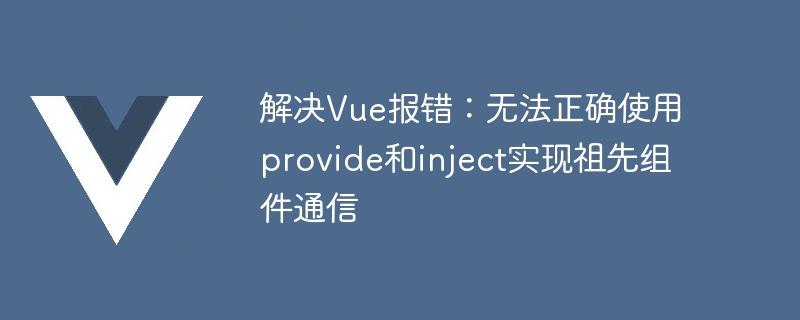Home >Web Front-end >Vue.js >Solving Vue error: unable to correctly use provide and inject to communicate with ancestor components
Solving Vue error: unable to correctly use provide and inject to communicate with ancestor components
- WBOYWBOYWBOYWBOYWBOYWBOYWBOYWBOYWBOYWBOYWBOYWBOYWBOriginal
- 2023-08-21 08:12:21940browse

Solution to Vue error: Unable to correctly use provide and inject to implement ancestor component communication
In Vue component development, we often need to implement communication between components. Vue provides several ways to achieve this, one of which is using provide and inject. But sometimes, when using these two APIs, you may encounter some problems, resulting in the failure to correctly implement communication between ancestor components and descendant components. This article will introduce the causes of this problem and give solutions.
In Vue, provide and inject are a pair of APIs. Provide is used to provide data in ancestor components, and inject is used to inject this data in descendant components. By using provide and inject together, communication between ancestor components and descendant components can be achieved.
However, there are some things to note when using provide and inject. First of all, provide and inject are implemented based on the relationship between components. Provide and inject can only work properly when there is a parent-child or ancestor-descendant relationship between components. Secondly, provide and inject are set during the component creation process, so only when the component is created, the provide data can be injected into the descendant components.
Next, let’s look at a specific example. Due to some reasons, an error occurred when using provide and inject. Suppose we have the following component structure:
<template>
<div>
<child-component></child-component>
</div>
</template>
<script>
import ChildComponent from './ChildComponent.vue';
export default {
components: {
ChildComponent
},
provide() {
return {
message: 'Hello from parent component'
};
}
}
</script>In this example, the parent component provides a message attribute and provides it to the child component through provide. The code in the child component is as follows:
<template>
<div>{{ message }}</div>
</template>
<script>
export default {
inject: ['message']
}
</script>In this code, the child component uses inject to inject the message attribute provided by the parent component into the message attribute of the child component for use in the child component.
However, when we try to run this code, the following error message may appear:
Property or method "message" is not defined on the instance but referenced during render.
This error message tells us that during the rendering process of the sub-component, an unknown value is being referenced. Defined properties or methods.
The reason for this error is that in Vue, the parent component is created before the child component is created. Provide is set during component creation. Therefore, when the child component is first created, the data provided by the parent component has not been set, causing the inject in the child component to be unable to inject correct data.
In order to solve this problem, we can use Vue's life cycle hook function to delay the creation of child components. Place the creation of the subcomponent in the parent component's create hook function to ensure that the provided data has been correctly set before being injected into the subcomponent.
The modified code is as follows:
<template>
<div>
<child-component v-if="showChild"></child-component>
</div>
</template>
<script>
import ChildComponent from './ChildComponent.vue';
export default {
components: {
ChildComponent
},
data() {
return {
showChild: false
}
},
created() {
this.showChild = true;
},
provide() {
return {
message: 'Hello from parent component'
};
}
}
</script>In this code, we place the creation of the subcomponent in a v-if directive and use a showChild attribute to control it show. In the created hook function of the parent component, set the showChild attribute to true to display the child component after the component is created.
Through this modification, we can ensure that the sub-component is created after the provide data is set, thereby solving the problem of being unable to correctly use provide and inject to implement communication between ancestor components and descendant components.
To sum up, when using Vue's provide and inject, you should pay attention to the parent-child or ancestor-descendant relationship between components, as well as the setting timing of provide data. If there is an error that you cannot use provide and inject correctly, you can use Vue's life cycle hook function to delay the creation of the subcomponent to ensure that the provided data has been set correctly before injecting it into the subcomponent.
The above is the detailed content of Solving Vue error: unable to correctly use provide and inject to communicate with ancestor components. For more information, please follow other related articles on the PHP Chinese website!

